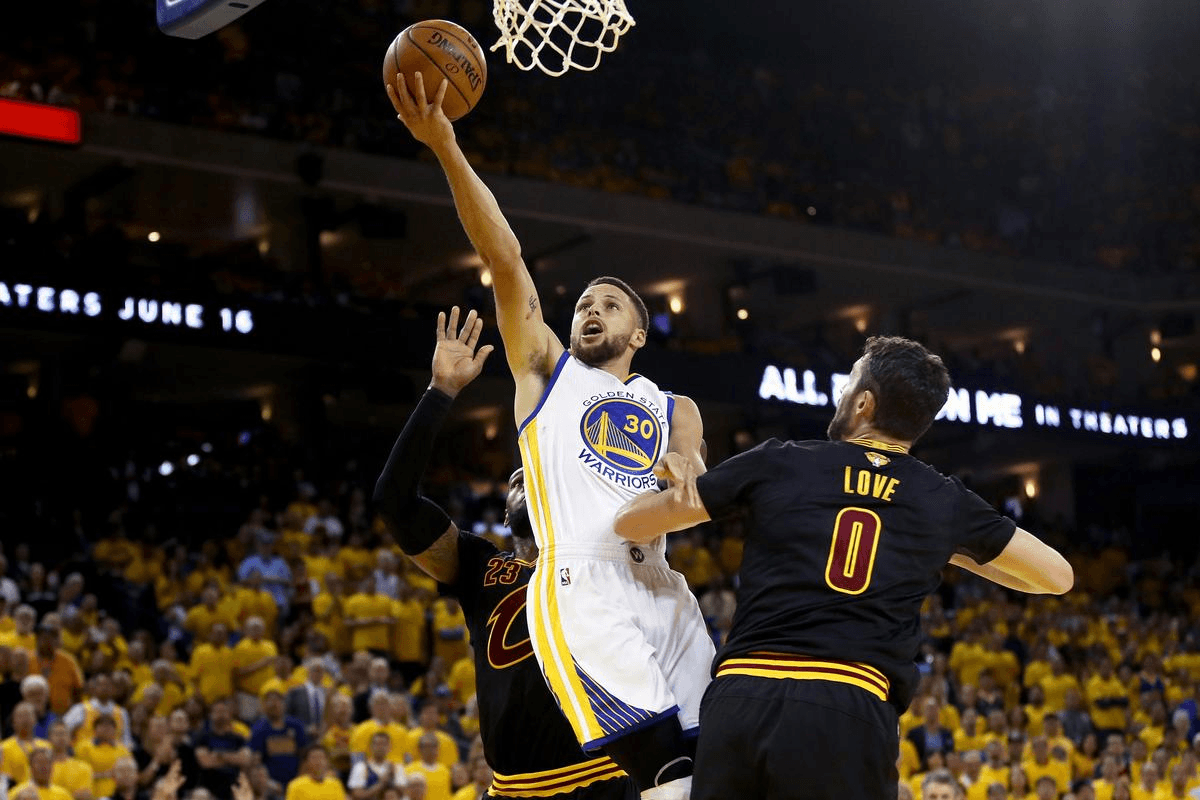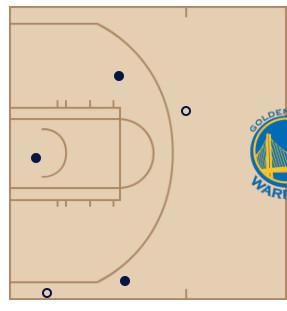
Not all blowouts are created equal. The Cavaliers lost Game 2 of the NBA Finals by 19 points, just three days after losing Game 1 by 22 points, with head coach Tyronn Lue even emptying his bench at the exact same time Sunday as he did last Thursday (the 4:00 mark of the fourth quarter). Yet Cleveland’s path to getting there was different, as it was able to keep Game 2 much more competitive. The Cavs were down by only three points going into halftime and forced Golden State head coach Steve Kerr, who returned to the bench after missing the past month with a lingering back injury, to make some unusual adjustments.
Playing the Warriors close is no small task. They feature two all-time greats, Kevin Durant and Steph Curry, operating at the peak of their powers, each of whom can impact a game in ways that we have never before seen. Durant finished Sunday with 33 points, 13 rebounds, six assists, five blocks, and three steals, while Curry chipped in a triple-double: 32 points, 11 assists, and 10 rebounds. Their play, combined with a bounce-back performance from Klay Thompson, who broke out of a prolonged shooting slump by going 8-of-12 from the field for 22 points, more than made up for Draymond Green being in foul trouble all night.
Draymond losing his cool and getting suspended was the turning point that sparked Cleveland’s comeback in the 2016 Finals, but Golden State barely felt his absence in prolonged stretches during Game 2. The Warriors just plugged Durant into Green’s spot, and the Cavs couldn’t match their firepower when both teams went all in on small ball with five perimeter players on the floor at the same time in the third quarter. LeBron James used to be Cleveland’s trump card in those situations, but Durant is just as athletic, skilled, and versatile. LeBron won’t be able to take over the Finals like he did last season. He has to work just to play Durant to a draw.
Here are seven takeaways from a 132–113 game that was closer than the final score would indicate.
1. It’s Kevin Durant’s World. We’re Just Living in It.
In a game that showcased the winners of seven of the past eight league MVP awards, Kevin Durant was the best player on the floor, putting together one of the best all-around outings of his career. Always a dominant individual scorer, KD is now one of the most effective defensive players in the NBA as well. The 7-foot 240-pounder combines the size and reach of a center with the speed of a guard, and he can switch screens and lock up perimeter players as easily as he can protect the rim.
When Green left the game with four fouls in the third quarter, Durant became the defensive anchor of Golden State’s small-ball lineup, and he was even better than the front-runner to win Defensive Player of the Year. Durant can guard LeBron, Kevin Love, and Kyrie Irving, and he blocked all three at different points during Game 2. Even Draymond has struggled to stay in front of Kyrie when he has been switched on him in this series, but Durant’s length can swallow him up on the perimeter:
The Warriors have beaten the Cavs by turning their defense into offense and thriving in transition, and no Golden State player got more stops or defensive rebounds than Durant did Sunday. Durant entered Game 2 having played as a center for eight minutes this season, according to nbawowy.com. Golden State didn’t want to risk injury by playing him at that position in the regular season, but that tactic has emerged as an incredible weapon in the playoffs.
LeBron isn’t the only queen on the Finals chessboard anymore. Durant can fill any hole the Warriors might have over the course of a game.
2. The Big Men Are Dropping Like Flies
Both teams played smaller in Game 1 than they had at any point during the playoffs, and they went even smaller in Game 2. The Warriors’ four-headed monster at center — Zaza Pachulia, JaVale McGee, David West, and James Michael McAdoo — combined for 31 minutes Sunday, while the Cavs split up Love and Tristan Thompson for huge chunks of the game. Durant and LeBron each started at small forward and spent most of the third quarter as small-ball centers. With so little size on the floor, the action unfolded at a dizzying pace, allowing players on both teams to rack up incredible stats.
Cleveland went at Golden State’s centers whenever they were in the game, liberally helping off Zaza on offense and attacking both McGee and West on defense. Lue played Love at the 5 and made a much more concerted effort to get him the ball, putting the Warriors bigs in the difficult position of chasing him around the 3-point line. Love finished 12-of-23 with 27 points and seven rebounds, and would have scored even more if he hadn’t missed a couple of chip-in putbacks on offensive rebounds. The toughest defender on Love was actually Durant; this block on a post-up was just rude:
The Cavs haven’t had much success playing Love and Thompson together in this series, as they are minus-27 in the 34 minutes both big men have been on the floor. Most of that time has come when the Warriors are playing their starters, and if Cleveland’s frontcourt can’t dominate when Zaza is in, there’s no real point in the team staying big. If Lue plays his bigs at the same time, that forces LeBron to guard KD or one of the Splash Brothers. James may not have enough gas in the tank to do that, run point, and push the pace at every opportunity.
3. LeBron Took His Foot Off the Pedal in the Second Half
Here’s the story of the game in two shot charts. In the first half, LeBron went 8-for-12 from the field, with all of his attempts coming in the lane:
In the third quarter, he took only five shots, with four of them coming from the perimeter:

LeBron has started each of the first two games in these Finals like he was shot from a cannon, putting his head down, mashing the turbo button, and making full-court rim runs whenever he grabs a defensive rebound. There’s not a more frightening sight in the NBA than LeBron barreling down the court with a full head of steam. However, it’s unrealistic to expect a player with as many miles on his body as LeBron to keep making plays like this for the entire game, especially given everything else that he is asked to do on both ends of the floor:
LeBron stopped attacking after halftime (he attempted just one shot in the fourth quarter), and the rest of the Cavs weren’t able to pick up the slack. Lue’s strategy in this series seems to be based on the belief that LeBron is a 25-year-old who can run and gun with the younger Warriors stars, not a 32-year-old who has to pick and choose his spots carefully. While James may get an extra burst of energy from the Cleveland crowd in Games 3 and 4, his endurance will be a key story line to watch if the Cavs continue playing at Golden State’s preferred uptempo pace.
4. The Cavs May Not Have Enough to Keep Pace in a Shootout
The last two games in Oracle Arena have exposed the age and lack of foot speed on the Cavs bench. Kyle Korver and Richard Jefferson are 36, Channing Frye is 34, and Deron Williams is 32 and playing on two bad ankles. It’s hard for them to keep up with the fast-paced Warriors, and Cleveland’s lack of athleticism on the wings negates a lot of the value of LeBron serving as a small-ball center. The Cavs need to rely heavily on J.R. Smith and Iman Shumpert in this series, but both of the Knicks cast-offs have so far been inconsistent at best.
Shumpert’s primary problem is offense. He is 3-for-12 from the floor over the first two games, with many of his field goal attempts coming when he has pressed the issue and attacked the Warriors off the dribble. On the other end of the court, he is Cleveland’s most athletic perimeter defender beyond LeBron, and its only other player capable of keeping up with KD for any amount of time. Durant can score on anyone, but Shumpert at least makes him work for his points. The Cavs need Shumpert’s length and athleticism on the perimeter, so they must figure out a way to channel his aggressiveness without having him short-circuit the offense in favor of ill-fated drives to the basket.
Smith, meanwhile, has disappeared completely in the Finals, scoring three points in 42 minutes, passing up open shots, and playing defense like he doesn’t even want to be there. He fouled the shooter four times in Game 2, with two of those coming on 3-pointers. The head-scratching part about his performance is how well he had excelled in a 3-and-D role in the first three rounds of the playoffs, taking the challenge of guarding Paul George and DeMar DeRozan while shooting 44.9 percent from deep. Defensive efforts like this are not good enough, and the Cavs have to hope that going home will reenergize Smith:
5. Steph Curry Decisively Won the Battle of the Point Guards
Other than the addition of Durant, the biggest change between Golden State in last year’s Finals and this year’s is how much better Curry is. After averaging 22.6 points and 3.7 assists on 40.3 percent shooting in June 2016 while slowed by a lingering knee injury, Curry is averaging 30 points and 10.5 assists on 46.2 percent shooting through the first two games this time around, and he’s once again playing with his trademark flair. He even got some revenge on LeBron for last season’s dismissive block and staredown, leaving him in the dust with this dribbling exhibition in the third quarter:
Kyrie is reportedly struggling with his own knee injury and hasn’t been able to re-create the magic from his scoring explosion in the 2016 Finals. He had 19 points on 8-of-23 shooting in Game 2, struggling against Golden State’s aggressive double-teams. The Warriors have clearly tried to make Kyrie a passer; he has not adjusted to their strategy, forcing up nearly impossible shots in traffic rather than passing to open teammates. Although Thompson hasn’t been a great scorer recently, he has to get the ball here:
The major difference between the star point guards in this series is that Steph can impact the game even on nights when his shot isn’t falling. He was only 4-of-11 from 3 on Sunday, but made up for it by getting to the free throw line 14 times and pulling down 10 rebounds. He’s a much smarter player than Kyrie is at this point in their respective careers, repeatedly getting open by taking advantage of his counterpart’s lax off-ball defense. Even when Kyrie tracks players through screens, he doesn’t always communicate with his teammates.
The Cavs aren’t playing the Celtics anymore. Plays like this cannot happen:
6. Cleveland Hasn’t Found a Lineup That Can Defend Golden State
Cleveland might be able to overcome the starpower deficit in this series if it had as many two-way players as Golden State does. That hasn’t been the case so far, as Lue’s rotations have exchanged offense for defense (and vice versa) without finding the right balance. Even LeBron isn’t the defender he was earlier in his career, and he’s still been by far the Cavs’ most reliable two-way player in these Finals.
Love provides a prime example of the dilemma facing Lue. The Cavs need Love’s unique combination of 3-point shooting and rebounding, and he seems to have figured out how to attack the Warriors, averaging 21 points and 14 boards in Games 1 and 2. However, he has given away nearly as many points as he has scored, particularly as the frenzied pace wears him down in the second half. Love is basically target practice for Curry and Durant in the pick-and-roll; they can both get open jumpers off the dribble whenever they want against him:
Lue has mostly tried to put as many 3-point shooters on the court as possible, but he may need to go with more athletic lineups that can keep up with Golden State in transition. Shumpert and Thompson have played only six minutes together in this series, and the Cavs need both on the floor to seemingly have any chance of slowing the Warriors. Cleveland should get better efforts from its role players at home, and Lue’s best option may be using those two with LeBron, Kyrie, and a more locked-in version of Smith.
7. The Warriors Need to Take Better Care of the Ball
Cleveland gave a much better defensive effort in Game 2 than it did in Game 1, but that alone doesn’t explain Golden State’s 20 turnovers on Sunday — 16 more than it had last Thursday. Carelessness with the ball has long been Golden State’s Achilles’ heel, and Curry was the Game 2 culprit, finishing with eight turnovers. The Warriors generate more of their offense through cuts than any other team in the NBA, so they throw plenty of high-risk passes through the lane. Still, that’s no excuse to give away possessions:
The Cavs have their backs against the wall, and they should play like it in Wednesday’s Game 3, much like they had to during the 2016 Finals. While the Warriors have been dominant through the first two games, they have left plenty of points on the board, and this series could return to Oracle for Game 5 if they don’t clean up some of their mistakes. The scary part for Cleveland, and for the rest of the NBA, is there’s still another level that Golden State can reach.

